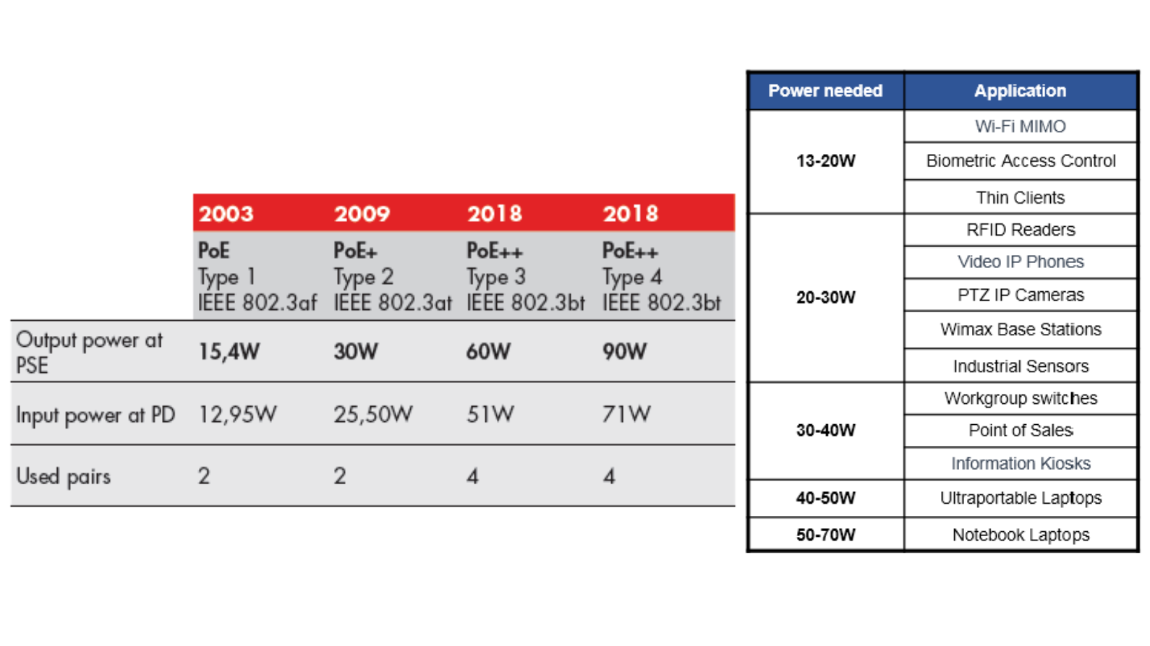- About Aginode
- Data Networks
- Telecom Infrastruktur
- Produkte
-
Ressourcen
- Ressourcen
- Documentation
- Blog
-
Case Studies
- Übersicht
- Innoasis development in Norway
- Eemsdelta Campus
- Hotelschool The Hague
- Emergency covid hospital, Hong Kong
- Société du Grand Paris
- Centrin Datacentres
- Airbus
- Athens Historic City Hall
- Pinewood Studios
- Goethe University Frankfurt
- Denmark New University Hospital
- University of Toulouse
- CHM Maubeuge: a model for future-ready hospitals
- Webinars
- Software Tools
- Warranty
- Newsroom
- Suchen
- Kontaktieren Sie uns
- Vergleichen
- Anmelden
Office & Enterprise
The 4 Types of PoE


When Power over Ethernet (PoE) was first standardised in 2003 nobody could have predicted how important and globally dynamic its market would be today. Under the stimulus of IP Convergence and the Internet of Things a wide variety of end devices were introduced into the network. And all require power. With time, the need for more power forced standardisation body IEEE to ratify higher power levels of PoE. This post looks at the 4 PoE Types and the power each delivers to the end device.
The 4 types of PoE
When the standardised PoE Type 1 first appeared in 2003 it managed to deliver 13W to the end device. To achieve that you required a Category 3 or Category 5 cable, 350mA of current and an Ethernet speed of up to 100Mbps.
6 years on, under the influence of IP convergence and an uptake of PoE devices, it became clear 350mA wasn’t enough. Advanced IP phones with large screens, access controls, Wireless Access Points supporting 802.11n technology and advanced IP security cameras needed more power to operate. So, in 2009 the standardisation body IEEE made Category 5e the minimum cable grade for PoE. With this new PoE Type 2 standard, 25.5W, using 600mA of current at a transmission speed of 1000Mbps, could be delivered to the end device. And for a while all was well…
But by 2018, IEEE was forced to act again and introduced a 3rd and 4th Type. PoE had meanwhile extended its reach to a myriad of devices. Once proprietary systems such as LED lighting, climate and access controls were now being converged to IP. Powering high-performance wireless access points, digital signage, advanced pan-tilt-zoom cameras and even desktop computers with Type 1 and 2 became impossible as they required more than 30W to function.
Type 3 supports 10Gbps as well as 2.5Gbps and 5Gbps to connect the latest 802.11ac Wireless Access Points. Using all 4 pairs of a copper data cable, instead of only 2 with Type 1 & 2, the amount of power doubled to 60W on transmit assuring 50 Watts ended up at the powered device. Type 4 was introduced to power large TVs, digital signage and laptops which require around 70W.

Kategorien
Unsere Websites
Wählen Sie Ihr Land aus, um unsere Produkte und Lösungen zu finden
-
Africa
- Africa
- Ghana
- Ivory Coast
- Morocco
- North West Africa
- Americas
- Asia
- Europe
- Oceania
